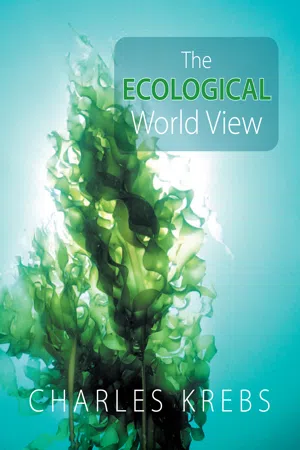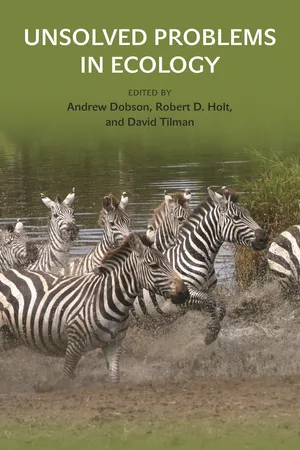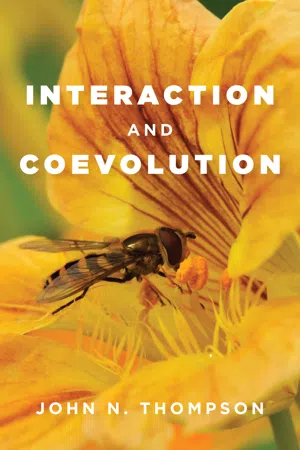Biological Sciences
Mutualism
Mutualism is a type of symbiotic relationship between two organisms in which both benefit from the association. This mutually beneficial interaction can involve various forms of cooperation, such as nutrient exchange, protection, or pollination. Mutualistic relationships are widespread in nature and play a crucial role in ecological communities, contributing to the overall stability and functioning of ecosystems.
Written by Perlego with AI-assistance
Related key terms
Related key terms
1 of 4
Related key terms
1 of 3
3 Key excerpts on "Mutualism"
- eBook - ePub
- Charles Krebs(Author)
- 2008(Publication Date)
- CSIRO PUBLISHING(Publisher)
commensalisms .Many Mutualisms have been known for hundreds of years. Bees pollinate flowers and gain by obtaining pollen as food, while the plants gain by gene flow (through movement of pollen) and seed fertilization. Nitrogen-fixing bacteria and mycorrhizal fungi inhabit the roots of plants and gain protection and carbohydrates from the plant while supplying nitrogen or other soil nutrients to the plant in exchange. But we should always remember that there are costs to Mutualisms as well as benefits, and we need to determine how the benefits exceed the costs for positive interactions. Ecologists first wish to describe these Mutualisms and then ask how they might affect the distribution and abundance of species in nature (Essay 9.1).9.2 MUTUALISTIC INTERACTIONS OCCUR WHEN ANIMALS POLLINATE AND DEFEND PLANTS
While it is tempting to think of Mutualisms in their simplest form as a two-species interaction—for example, between a particular pollinator and a particular plant species—in natural ecosystems specialized, two-species partnerships are rare. We must remember to think instead of multi-species systems in which, for example, many insects pollinate a particular plant, and a single pollinator may use pollen from several different plant species. For simplicity, most natural history studies concentrate on two-species interactions, from which we can gradually build a more complex picture. Let us consider two examples of Mutualisms.ESSAY 9.1 WHY ARE CORALS BLEACHING?
Coral reef bleaching has increased dramatically in many tropical areas around the globe in the last 20 years. Corals are animals that contain symbiotic algae within their cells, and this symbiotic relationship is one of the most important Mutualisms in the biosphere. The symbiotic algae provide color to the corals and undertake photosynthesis, thus contributing to coral growth—a positive relationship. When corals bleach they lose their symbiotic algae, and therefore their color, and often die. Widespread bleaching can cause the death of whole coral reefs. The primary cause of coral bleaching is thought to be elevated sea surface temperatures. Many reef-building corals live very close to their upper lethal temperatures, and small increases of 0.5 to 1.5°C over a few weeks, or larger increases of 3–4°C over several days, can kill corals (Huppert and Stone 1998 - eBook - ePub
- Andrew Dobson, David Tilman, Robert D. Holt, Andrew Dobson, David Tilman, Robert D. Holt(Authors)
- 2020(Publication Date)
- Princeton University Press(Publisher)
A new ecosystem approach—on an earthwide scale—is the Gaia hypothesis (Lovelock 1988). Whereas a traditional ecosystem study focused on how its species served their ecosystem’s function, Gaia focuses on how the activities of the earth’s organisms collectively make its environment, especially the earth’s temperature, atmospheric composition, and its ocean, river, and soil chemistry more hospitable to life. Automatic, active but unconscious feedback processes maintain this homeostasis. However, “the conditions are only constant in the short term and evolve in synchrony with the changing needs of the biota as it evolves.” (Lovelock 1988, p. 19). Neither an ecosystem nor the ensemble of biogeochemical processes affecting life on earth are true superorganisms because, unlike honeybee colonies, these entities are not organized to reproduce. Nonetheless, natural ecosystems are organized to maintain high productivity and diversity, as evidenced by the circumstance that disturbance outside an ecosystem’s evolutionary experience reduces its productivity and/or diversity (Leigh and Vermeij 2002). Moreover, living things have collectively modified the earth’s surface, making it more suitable for life. Most geochemical cycles have come increasingly under biotic control as life evolved (Vermeij 2013, p. 13; Vermeij 2011, pp. 199–202), so the world is a far better home for life now than 3.7 billion years ago. Ecosystems, individually and collectively, have these features because “by establishing feedbacks between species and enabling factors [factors enhancing access of species to essential resources], effective competitors regulate and enhance resource supply (Vermeij 2013, p. 1).Nonetheless, community ecologists rejected the hypothesis of ecosystems as adaptively organized and the Gaia hypothesis that, thanks to their relationships of interdependence, living things collectively make the earth better for life. They did not see how natural selection within populations could favor these developments. Similarly, geologists initially rejected the idea of continental drift even though it fit the facts, because they knew no mechanistic cause for it—but they had to discover new phenomena to explain continental drift, whereas Odum had already proposed the mechanism that shaped ecosystem adaptation and life’s impact on its environment.Although how Mutualism helps make organisms better competitors or predators has been studied for decades (Smith and Douglas 1987), as has interdependence among ecosystems (Keast and Morton 1980), Williamson (1972, p. 95) remarked that Mutualism “is a fascinating biological topic, but its importance in populations in general is small.” In their book on symbiosis (a form of Mutualism where one partner lives in the other), Smith and Douglas (1987) assembled evidence that Mutualism—between eukaryotes and their mitochondria, plants and their chloroplasts and mycorrhizae, wood-decomposing termites and the cellulose-consuming protists in their guts, corals and their zooxanthellae—is as vital to the productivity of many, if not most, natural ecosystems as cooperative enterprise is to modern human economies, However, they found that, intracellular organelles excepted, “most biologists consider that the evolutionary importance of symbiosis has been trivial compared to the other mechanisms by which novel and heritable characteristics are produced” (Smith and Douglas 1987, p. 237). Pastor (2008, pp. 169–173) briefly discussed models of Mutualism, but this discussion had no impact on the rest of his book. How could this happen? - eBook - ePub
- John N. Thompson(Author)
- 2014(Publication Date)
- University of Chicago Press(Publisher)
CHAPTER 4 ANTAGONISM AND MutualismMutualisms between species encompass an odd conglomeration of interactions in a world often viewed as “red in tooth and claw.” Although a wide variety of Mutualisms has been described, we still have only a rudimentary understanding of the selection pressures, life history traits, and community attributes that favor the origination and maintenance of these interactions. This lack of a solid understanding of the ecological conditions favoring Mutualisms is reflected in the literature on mathematical models of Mutualisms. Some mathematical and conceptual models conclude that Mutualisms should be expected to be less common in nature than antagonistic interactions, because the models of Mutualism often exhibit high degrees of instability (e.g. May, 1973; Van Valen, 1973; Goh, 1979). Other mathematical models of Mutualism in coevolving species sometimes exhibit stability depending upon the parameters in the models (e.g. Roughgarden, 1975; Levin and Udovic, 1977; Vandermeer and Boucher, 1978; Heithaus et al., 1980; Addicott, 1981). The most reasonable interpretation of the attempts at modeling Mutualisms over the past decade is not that Mutualisms are uncommon—the empirical evidence is to the contrary—but rather that we know little about the ecological bases for Mutualisms relative to antagonistic interactions. I think both modelers and field ecologists would agree with this interpretation. In the book Theoretical Ecology , May (1976, 1981) writes that he would have liked to include a chapter on Mutualism much like the chapters in the book on arthropod predator–prey systems, herbivore–plant systems, and competition and niche theory. He did not because he thought that both the theoretical and empirical bases of Mutualism were still insufficiently known to be summarized as a separate chapter.Nevertheless, there are several fronts on which the theory of Mutualism is advancing and some initial syntheses are emerging. This chapter and Chapters 5 and 6
Index pages curate the most relevant extracts from our library of academic textbooks. They’ve been created using an in-house natural language model (NLM), each adding context and meaning to key research topics.
Explore more topic indexes
Explore more topic indexes
1 of 6
Explore more topic indexes
1 of 4


